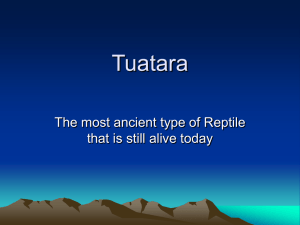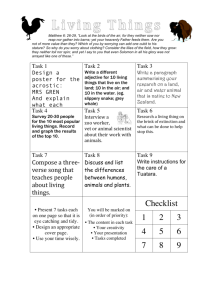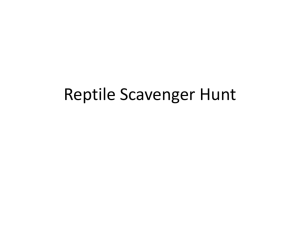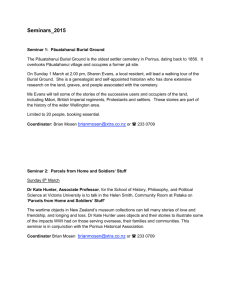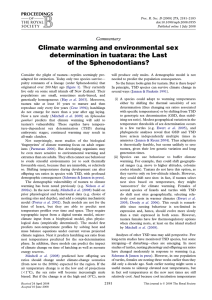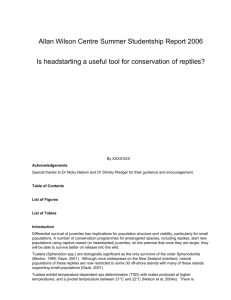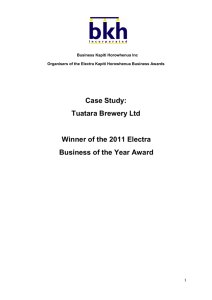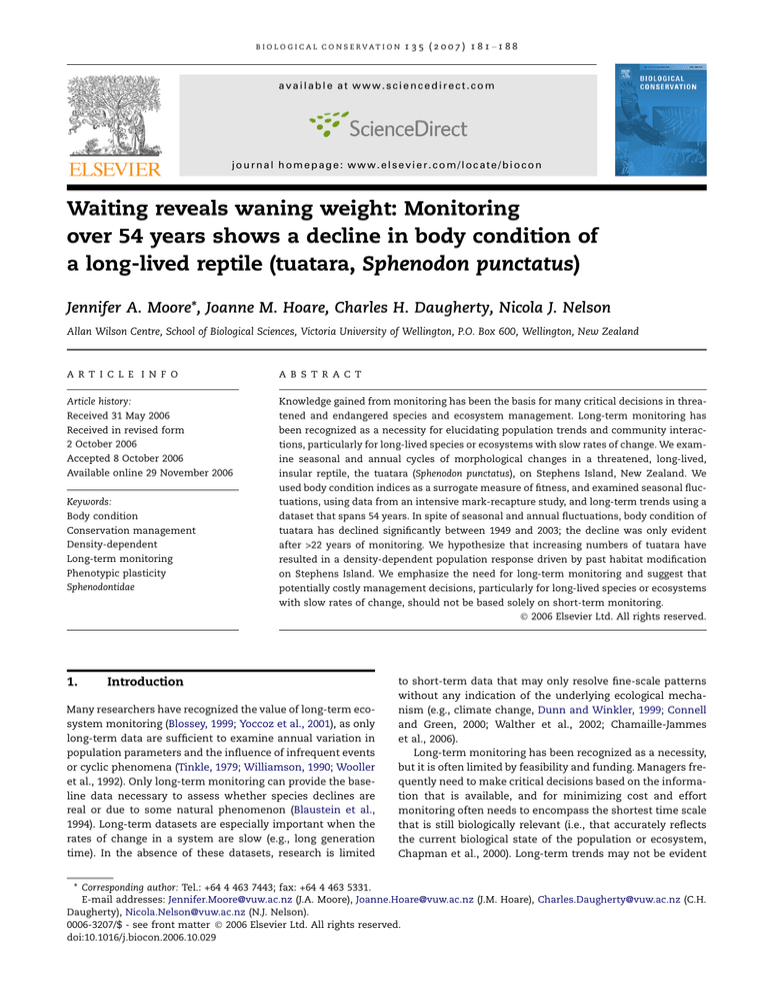
B I O L O G I CA L C O N S E RVAT I O N
1 3 5 ( 2 0 0 7 ) 1 8 1 –1 8 8
available at www.sciencedirect.com
journal homepage: www.elsevier.com/locate/biocon
Waiting reveals waning weight: Monitoring
over 54 years shows a decline in body condition of
a long-lived reptile (tuatara, Sphenodon punctatus)
Jennifer A. Moore*, Joanne M. Hoare, Charles H. Daugherty, Nicola J. Nelson
Allan Wilson Centre, School of Biological Sciences, Victoria University of Wellington, P.O. Box 600, Wellington, New Zealand
A R T I C L E I N F O
A B S T R A C T
Article history:
Knowledge gained from monitoring has been the basis for many critical decisions in threa-
Received 31 May 2006
tened and endangered species and ecosystem management. Long-term monitoring has
Received in revised form
been recognized as a necessity for elucidating population trends and community interac-
2 October 2006
tions, particularly for long-lived species or ecosystems with slow rates of change. We exam-
Accepted 8 October 2006
ine seasonal and annual cycles of morphological changes in a threatened, long-lived,
Available online 29 November 2006
insular reptile, the tuatara (Sphenodon punctatus), on Stephens Island, New Zealand. We
used body condition indices as a surrogate measure of fitness, and examined seasonal fluc-
Keywords:
tuations, using data from an intensive mark-recapture study, and long-term trends using a
Body condition
dataset that spans 54 years. In spite of seasonal and annual fluctuations, body condition of
Conservation management
tuatara has declined significantly between 1949 and 2003; the decline was only evident
Density-dependent
after >22 years of monitoring. We hypothesize that increasing numbers of tuatara have
Long-term monitoring
resulted in a density-dependent population response driven by past habitat modification
Phenotypic plasticity
on Stephens Island. We emphasize the need for long-term monitoring and suggest that
Sphenodontidae
potentially costly management decisions, particularly for long-lived species or ecosystems
with slow rates of change, should not be based solely on short-term monitoring.
Ó 2006 Elsevier Ltd. All rights reserved.
1.
Introduction
Many researchers have recognized the value of long-term ecosystem monitoring (Blossey, 1999; Yoccoz et al., 2001), as only
long-term data are sufficient to examine annual variation in
population parameters and the influence of infrequent events
or cyclic phenomena (Tinkle, 1979; Williamson, 1990; Wooller
et al., 1992). Only long-term monitoring can provide the baseline data necessary to assess whether species declines are
real or due to some natural phenomenon (Blaustein et al.,
1994). Long-term datasets are especially important when the
rates of change in a system are slow (e.g., long generation
time). In the absence of these datasets, research is limited
to short-term data that may only resolve fine-scale patterns
without any indication of the underlying ecological mechanism (e.g., climate change, Dunn and Winkler, 1999; Connell
and Green, 2000; Walther et al., 2002; Chamaille-Jammes
et al., 2006).
Long-term monitoring has been recognized as a necessity,
but it is often limited by feasibility and funding. Managers frequently need to make critical decisions based on the information that is available, and for minimizing cost and effort
monitoring often needs to encompass the shortest time scale
that is still biologically relevant (i.e., that accurately reflects
the current biological state of the population or ecosystem,
Chapman et al., 2000). Long-term trends may not be evident
* Corresponding author: Tel.: +64 4 463 7443; fax: +64 4 463 5331.
E-mail addresses: Jennifer.Moore@vuw.ac.nz (J.A. Moore), Joanne.Hoare@vuw.ac.nz (J.M. Hoare), Charles.Daugherty@vuw.ac.nz (C.H.
Daugherty), Nicola.Nelson@vuw.ac.nz (N.J. Nelson).
0006-3207/$ - see front matter Ó 2006 Elsevier Ltd. All rights reserved.
doi:10.1016/j.biocon.2006.10.029
182
B I O L O G I C A L C O N S E RVAT I O N
or may be misinterpreted if monitoring duration is insufficient (Madsen and Shine, 2001; Thomas et al., 2002), which
could result in inappropriate, costly management decisions.
Initial monitoring may reveal population trends that are manifested as individual morphological changes (Adler and Levins, 1994; for short-lived species), which would ultimately
affect population dynamics.
So how long does a population need to be monitored before trends become evident and appropriate management
decisions can be made? We address this question by investigating the seasonal and annual cycles of morphological
changes in one population of a threatened, long-lived, insular
reptile, the tuatara (Sphenodon punctatus). We use intensive
mark-recapture data and a dataset spanning 54 years, to
interpret body condition responses with respect to climate,
reproduction, habitat modification, and monitoring duration.
Tuatara are medium-sized reptiles and the sole extant representatives of the Order Sphenodontia (Benton, 2000). Endemic to New Zealand, they were once widespread throughout
the main and outlying islands (Holdaway and Worthy, 1997),
but by the early 19th Century, these long-lived reptiles (maximum recorded longevity is 91 years, N.J.N., personal communication) were extirpated on the two main islands,
presumably as a result of habitat modification and introduction of rodents (Rattus exulans) by human settlers (750 ya;
Anderson, 1996). Much of the habitat on the approximately
30 offshore islands on which tuatara naturally remain has
been heavily modified.
Over half of extant tuatara (30–50,000 individuals) inhabit
ori name, TakStephens Island (known also by its Ma
apourewa; Marlborough Sounds, 40°40 0 S, 174°00 0 E), which
has been the focus of scientific research since 1949 (Dawbin,
1962, 1982a,b) and is the source island for two translocated
populations (Nelson et al., 2002; N.J.N. unpublished data).
The 150 ha island supports a lighthouse and has a history of
intensive habitat modification. By the mid-1920s, following
constant human presence by permanent lighthouse keepers,
an estimated 80% of the island’s forested habitat had been
cleared for farming and speculation was raised over the small
number of tuatara remaining after intensive collection for
museum specimens (Brown, 2000). Cleared paddocks had
been maintained on the island until removal of livestock in
2004, with little natural revegetation since the initial deforestation. Although reforestation efforts have been ongoing,
remnant coastal forest now covers less than 15% of the island
(Hare and Cree, 2005), and in forest remnants, the average
density of tuatara is about 2015 per hectare, which is five
times greater than in the artificial paddocks (Carmichael
et al., 1989), and at least 20 times greater than on any other
island where tuatara naturally occur (Cree and Butler, 1993).
In order to reveal demographic patterns and potential impacts to this biologically significant source population, we
examine seasonal and long-term trends in body condition
(a measure of mass relative to body size). Specifically, the following questions are addressed: (1) Are long-term trends or
cycles in body condition evident, and do these vary between
the sexes? (2) Does body condition of tuatara fluctuate seasonally, or with respect to sex or climate? (3) How many years
of monitoring may be necessary to reveal significant longterm trends?
1 3 5 ( 2 0 0 7 ) 1 8 1 –1 8 8
2.
Materials and methods
2.1.
Long-term body condition trends
Mark-recapture data were collected from Stephens Island tuatara from 25 separate years, spanning the period 1949–2003. In
most sampling years, data were collected during multiple
sampling trips, and the times of the sampling trips varied
by year. Tuatara caught between 1949 and 1992 were given
permanent individual marks by toe-clipping when first captured, and recaptures were recorded. After 1992 toe-clipping
was no longer used to permanently mark individuals. During
the 2003 trip, a unique number was written on the side of
each animal with a permanent marker pen, which was legible
for the duration of the sampling period only.
From 1983 to 1985, only females were captured, as markrecapture data are derived from a nesting study (Newman
et al., 1994). Therefore we removed these years from intersexual analyses but retained them for subsequent female-only
analyses. Morphological measurements taken from captured
tuatara included sex, snout to vent length (SVL; mm) and
mass (g) (Table 1). The sex of each adult tuatara (P170 mm
SVL) was easily determined by examining secondary sexual
characteristics, including crest development, spine shape,
head size/shape, and shape of abdomen (Dawbin, 1982a; Cree
et al., 1991).
We calculated body condition indices to assess trends in
tuatara body condition. Body condition, which is often used
as a surrogate measure of fitness, reflects an animal’s storage
and expenditure of energy, which can sometimes reveal the
stresses or limitations affecting those individuals (Doughty
and Shine, 1998; Moore et al., 2000; Schulte-Hostedde et al.,
2001). Recent debate has raised cautions about generating
false relationships between condition and other parameters
correlated with body size (Green, 2001; Schulte-Hostedde
et al., 2005). However, with proper testing of assumptions,
body condition indices provide a powerful, non-destructive
technique for examining body mass changes over time, while
accounting for allometric growth (Bradshaw et al., 2000; Shine
et al., 2001). We defined body condition as the residual values
from a linear regression of log(mass) versus log(SVL), because
it was the most appropriate for our dataset and meets the
assumption of linearity (r2 = 0.95).
Body condition indices were used to assess long-term
intersexual trends in tuatara body condition by carrying out
a repeated measures analysis of variance (ANOVA) with a linear mixed effects model. The dependent variable was body
condition of tuatara. We included sampling period (year)
and sex as dependent fixed effects, and individual as an independent random effect. We used Akaike’s Information Criterion (AIC; Akaike, 1973; Burnham and Anderson, 1998) for
statistical model selection. For these analyses, we used data
from all years in which both males and females were caught.
Upon finding a significant effect of sex and time on tuatara
body condition, we explored temporal trends in body condition for each sex. We constructed models for adult females
and males separately, including data from all sampling years,
to assess trends using linear mixed effects models which accounted for individual variability. Models compared were
those in which body condition (1) remained constant over
B I O L O G I C A L C O N S E RVAT I O N
183
1 3 5 ( 2 0 0 7 ) 1 8 1 –1 8 8
Table 1 – Sample sizes (N), mean snout-vent length (SVL, mm), mass (g), and standard errors (SE) for all tuatara (Sphenodon
punctatus) measured on 25 sampling trips to Stephens Island. Only females were sampled from 1983 to 1985
Year
Females
Males
Mean
1949
1950
1951
1953
1954
1955
1956
1957
1965
1968
1971
1972
1975
1976
1977
1978
1980
1983
1984
1985
1986
1987
1988
1992
2003
Mean
Mean
SVL
SE
Mass
SE
N
SVL
SE
Mass
SE
14
29
9
37
78
6
12
19
36
21
53
72
21
14
19
5
14
127
87
112
42
165
90
62
133
198
205
212
197
197
211
206
219
204
204
206
201
211
203
202
207
210
201
199
199
217
204
206
199
195
5
3
11
3
2
10
5
8
2
3
2
2
3
4
3
7
4
1
1
1
1
1
1
2
1
361
332
378
314
324
376
348
475
357
351
295
283
354
311
324
295
357
330
333
294
419
305
319
292
256
27
17
33
7
6
10
8
7
5
5
4
5
5
6
5
4
4
4
4
5
2
4
4
4
5
28
82
16
51
77
23
7
29
47
34
71
53
27
18
21
16
20
–
–
–
27
8
8
25
154
235
244
242
235
236
242
239
230
239
249
252
243
239
232
243
235
252
–
–
–
229
231
213
240
229
5
3
8
5
4
7
11
7
3
3
3
3
5
6
4
9
4
–
–
–
4
12
11
6
2
616
596
610
554
583
573
628
558
586
622
569
536
544
472
565
485
623
–
–
–
484
473
375
555
454
39
23
50
32
24
45
89
48
23
20
17
21
33
41
31
51
28
–
–
–
20
60
55
33
11
time, (2) fluctuated through time, and (3) showed a linear increase or decrease over time.
We further explored the long-term dataset (for both males
and females) using the same analysis as above, in the following ways (1) all data exclusive of 1949 and 2003 (as these
appeared to have a potentially strong influence on the trend),
(2) only data from years that were sampled in the same
month (to test for a seasonal sampling effect), and (3) all data
in 10 year, 30 year, and multiple-year additive blocks (to assess the monitoring duration necessary to reveal consistently
significant trends).
We obtained maximum yearly rainfall data for Stephens
Island over the last 150 years (C. Allen, unpublished data).
These data were analyzed using an ANOVA with a linear
mixed effects model to determine whether rainfall has fluctuated significantly through time, or whether any linear trends
are evident that may help to explain any patterns in tuatara
body condition.
2.2.
Mean
N
Seasonal body condition trends
Upon finding significant fluctuations in the long-term dataset
we investigated potential seasonal cycles in body condition by
recording morphological data from Stephens Island tuatara
on four trips (November 2004, January, March, May 2005) in
three study plots in Keepers Bush (an original forest remnant). The centers of the study plots were randomly located
from an accessible track running through the bush. All tuatara within two circular plots 10 m in radius, and one 14 m
radius were captured, and their locations in the plot were recorded. Repeated captures of these individuals were made in
November 2004 (over seven days, seven nights; austral
spring), January 2005 (four days, four nights; austral summer),
March 2005 (four days, four nights), and May 2005 (five days,
five nights; austral autumn). We marked each individual
using a passive integrated transponder (PIT) tag (AVID, Folsom, Louisiana, USA). At each capture, SVL (mm), mass (g),
and sex were recorded. These data were not included in the
long-term analysis, as they were collected from a different
sample of tuatara, and the body condition indices generated
from this analysis are relative and not directly comparable
to those generated from the long-term analysis.
To assess seasonal trends in tuatara body condition, we
carried out a repeated measures ANOVA with a linear mixed
effects model. Body condition of tuatara was the dependent
variable. Trip, plot, and sex were dependent fixed effects,
and individual was included as an independent random
effect. Because juveniles were not sampled in all trips, and
were only caught in very low numbers, we did not include
them in this analysis. Models were screened based on AICs
(Akaike, 1973; Burnham and Anderson, 1998), and we then rescaled the values to the lowest AIC, to give relative AIC values
(DAIC). Those models with the lowest AIC values provide the
best explanation of variance.
We used correlation tests with seasonal data to examine
the relationship between body condition and (1) maximum
monthly rainfall, (2) maximum monthly rainfall from one
month prior to sampling month (to test whether there was
184
B I O L O G I C A L C O N S E RVAT I O N
a delayed response in condition), and (3) average monthly
temperature. These climatic data were obtained for Stephens
Island, and included maximum monthly rainfall (mm) and
average monthly ambient temperature for the period October
04–June 05 (C. Allen, unpublished data).
All data sets satisfied the assumptions of normality and
homogeneity of variances. Means are reported as mean ±
1 SE, and significance is assumed at p < 0.05. All analyses
were carried out using the computer program R (www.
rproject.org).
Table 2 – Results of linear mixed effects models of body
condition index of tuatara (Sphenodon punctatus) from
Stephens Island, including rescaled AIC (DAIC) and
degrees of freedom (DF)
DAIC
DF
Seasonal models
Trip
Trip + sex
Trip + plot
Trip + plot + sex
Trip + sex + (trip * sex)
Trip + plot + (trip * plot)
Null
Sex
Plot
0.00
4.77
14.65
19.13
25.43
39.62
127.83
131.52
142.09
6
7
8
9
10
12
3
4
5
Long-term models
Sex + year
Year
Sex + year + (sex * year)
Null
Sex
0.00
32.87
115.85
501.56
504.83
25
24
46
3
4
The model with the lowest DAIC best explains the variance in the
seasonal and long-term dataset.
1 3 5 ( 2 0 0 7 ) 1 8 1 –1 8 8
3.
Results
3.1.
Long-term body condition trends
From 1949 to 2003, there was a 105 g decrease in average
female mass, with only a 2 mm decrease in average SVL.
Males showed a 162 g decrease in average mass, with only a
6 mm decrease in average SVL (Table 1). Between 1949 and
2003 a total of 2508 captures were made of 1888 adult tuatara.
The heaviest tuatara was an adult male captured in 1950,
weighing 1020 g (SVL = 285 mm). Three other adult males
weighing 1000 g were captured during this period (the same
individual, in 1957, and two different individuals in 1954
and 1957; SVL = 270 and 280 mm respectively). By 2003 maximum mass of adult male tuatara had declined to 770 g
(SVL = 267 mm). The heaviest female tuatara was captured
in 1953 and weighed 690 g (SVL = 267 mm). A further 3 captures of females weighing P550 g have been made, all in
the period 1950–1956. By 2003 maximum mass for female tuatara was 480 g (SVL = 240 mm).
Both sex and year were significant main effects identified
by AIC model selection (DAIC = 0.0, compared with a null
model of DAIC = 501.6; Table 2). The next best model, where
year is included as the single main effect, is a significantly
poorer predictor of tuatara body condition (DAIC = 32.9). Adult
male tuatara had higher body condition than adult females
(males, mean = 0.02 ± 0.004; females, mean = 0.02 ± 0.004;
Fig. 1). The lack of a significant interaction between year
and sex (DAIC = 115.9) demonstrates that temporal variation
in body condition is not sex-specific.
Body condition fluctuated significantly through time, compared with a model treating body condition as constant with
respect to time (males v213 ¼ 250:1, p < 0.0001; females
v213 ¼ 490:5, p = 0.0001; Fig. 1). Furthermore, from 1949 to
2003 body condition of both adult male and adult female tuatara declined significantly. A linear decline in condition fits
0.25
0.20
Body Condition Index
0.15
0.10
0.05
0.00
-0.05
-0.10
-0.15
-0.20
-0.25
1945
1955
1965
1975
1985
1995
2005
Sampling Year
Fig. 1 – Long-term trend of body condition decline for male (d, - -, r2 = 0.37) and female (s, –, r2 = 0.22) tuatara (Sphenodon
punctatus) from 1949 to 2003 on Stephens Island, New Zealand.
B I O L O G I C A L C O N S E RVAT I O N
0.12
Table 3 – Results of linear mixed effects models of body
condition of male and female tuatara of varying sampling periods using reduced datasets collected from
Stephens Island over the period 1949–2003
Females
0.10
0.08
Body Condition Index
Time span
Males
t value
p value
t value
p value
10-year blocks
1950–1960
1960–1970
1970–1980
1980–1990
1990–2000
0.6
0.1
5.2
7.4
4.5
0.6
0.9
<0.0001*
<0.0001*
0.0026*
0.002
3.5
3.0
0.6
3.0
1.0
0.004*
0.02*
0.7
0.1
30-year blocks
1950–1980
1960–1990
1970–2000
8.2
3.0
4.7
<0.0001*
0.006*
<0.0001*
7.8
2.7
1.0
0.06
0.04
0.02
0.00
-0.02
-0.04
-0.06
-0.08
-0.10
<0.0001*
0.01*
0.3
Nov 04
Jan 05
Mar 05
May 05
Sampling Trip
Fig. 2 – Mean seasonal body condition (±1 SE) of male (d) and
female (s) tuatara (Sphenodon punctatus) sampled from four
trips to Stephens Island.
Direction of t-values (positive or negative) indicates the direction of
the linear trend over time, and asterisks indicate significance
(p < 0.05).
over four trips between November 2004 and May 2005. Individual recaptures increased with time, and new captures decreased with time until they approached zero (Table 4). We
found a significant positive relationship between body mass
and SVL (linear regression, r2 = 0.95, P < 0.001). Snout-vent
length averaged 196.6 ± 0.9 mm (female) and 261.7 ± 3.7 mm
(male), and mass averaged 231.8 ± 1.5 g (female) and
473.8 ± 9.0 g (male). Body condition was significantly higher
in males (mean = 0.02 ± 0.009) than in females (mean =
0.03 ± 0.006) or juveniles (mean = 0.08 ± 0.006).
The univariate model including trip explained the greatest
amount of variance in body condition (AIC = 929.1,
DAIC = 0.0), followed by trip + sex (DAIC = 4.8; Table 2). However, because the trip + sex model is not within two AIC units
of the best model, we did not consider it to be competitive
with the top model (Burnham and Anderson, 1998). Body condition was significantly lower in March (mean = 0.06 ± 0.01;
p < 0.001) and higher in May (mean = 0.06 ± 0.006) than at
other times of the year (Fig. 2).
The warmest months during the sampling period were
February 05 (mean temp = 18.0 °C), followed by March 05
(mean temp = 16.0 °C). There was no significant correlation
between mean body condition and mean monthly temperature (r = 0.6, p = 0.3). The maximum rainfall was highest in
May 05 with 136.1 mm, and lowest in April 05 with 4.1 mm.
There was also no significant correlation between body condition and maximum monthly rainfall (r = 0.4, p = 0.6), or maximum monthly rainfall one month prior to the sampling
month (r = 0.2, 0.8).
the data better than a model where condition is constant over
time in adult tuatara of both sexes (males v27 ¼ 79:6, p < 0.0001;
females v27 ¼ 67:8, p < 0.0001; Fig. 1). The decline remained significant even when the analyzed dataset did not include data
from 1949 and 2003 (indicating that these years did not disproportionately skew the results), and when the dataset only
included years that were sampled in the same month (indicating no effect of sampling season).
A consistently significant decline in body condition only
became evident after including >22 years of data (starting in
1949). When each decade of data was analyzed separately,
no clear patterns were evident and results varied from significant linear increases (e.g., females 1970–1980, t = 5.2,
p < 0.001) to periods with constant body condition indices
(e.g., females 1950–1960, t = 0.6, p = 0.58; males 1980–1990,
t = 0.6, p = 0.7) to significant linear declines (e.g., females
1980–1990, t = 7.4, p < 0.0001; males 1960–1970, t = 3.5,
p < 0.01). Regardless of the starting date, datasets that included at least 30 years of data all revealed significant declines in body condition, with the exception of males from
1970 to 2000 (Table 3). Annual rainfall has remained relatively
constant over time, and did not exhibit any significant linear
trends (F1,52 = 1.7, p = 0.2).
3.2.
185
1 3 5 ( 2 0 0 7 ) 1 8 1 –1 8 8
Seasonal body condition trends
From the three study plots, we recorded 461 captures, from
201 individual tuatara (107 males, 87 females, 7 juveniles),
Table 4 – Frequency of new captures and recaptures, and mean body condition index of all tuatara (Sphenodon punctatus)
sampled on four trips to Stephens Island (M = males, F = females, and J = juveniles)
Trip
November 04
January 05
March 05
May 05
New captures
Recaptures
Mean body condition index
M
F
J
M
F
J
62
34
7
4
38
39
7
3
2
0
3
2
0
41
48
50
0
34
48
37
0
0
1
1
0.009
0.002
0.070
0.052
186
4.
B I O L O G I C A L C O N S E RVAT I O N
Discussion
Over the past 54 years, tuatara body condition has decreased
significantly over time, with adult male tuatara having consistently higher body condition than adult females, although
both sexes have declined at a similar rate. Body condition of
both sexes of tuatara appears to fluctuate seasonally and is
lowest in March (austral autumn).
The most obvious cause of a seasonal decline in body condition during the mating season (March) is from increased
energetic costs of reproductive activity. Plasma levels of oestradiol in female tuatara from Stephens Island are highest in
February - March, which is indicative of vitellogenesis (Cree
et al., 1992). Furthermore, Cree et al. (1992) found a peak in
testosterone of female and male tuatara, and a peak in corticosterone in males (Tyrrell and Cree, 1998) at this time. High
testosterone levels are known to increase mobility and social
contact of reptiles during mating (Wada, 1982; Ketterson and
Nolan, 1992; Denardo and Sinervo, 1994). In tuatara, mite
infestation (Neotrombicula sphenodonti and N. naultini, Acari:
Trombiculidae, Goff et al., 1987) also peaks during the breeding season, and is evident by obvious orange patches on the
skin that are absent at other times of the year (S. Godfrey,
unpublished data; J.A.M., personal observation). Testosterone,
in addition to increased physical contact, could therefore
have a similar effect of lowered body condition and increased
ectoparasite intensity of tuatara. Further research is needed
to confirm this hypothesis and because our seasonal dataset
is somewhat limited, our conclusions remain speculative.
Despite monthly and annual fluctuations, rainfall levels on
Stephens Island have remained constant over the past 150
years, with no significant increases or decreases. A long-term
decline in body condition was also found for neighboring
North Brother Island tuatara, S. guntheri (an island which is
very similar to Stephens in habitat modification history and
geographic locale). After fully exploring potential climatic
influences (including long-term cyclic events), Hoare et al.
(2006) found no significant correlations between climate and
body condition. Although there is no source of fresh water
on Stephens Island, and the animals are highly dependent
upon rainfall, because rainfall levels have remained steady
over time it does not appear that climate changes are responsible for the body condition decline.
A more likely hypothesis is that the decline may be a density dependent response to resource competition from a steadily increasing number of tuatara. There is anecdotal
evidence of intensive collection pressure on Stephens Island
tuatara in the late 19th to early 20th centuries. This, coupled
with the clearing of over 80% of the forest for farming (likely
their preferred habitat, as evidenced by the much higher densities in the forest than in cleared areas; Carmichael et al.,
1989) could have caused a temporary bottleneck in this population (Brown, 2000). With time, female tuatara took advantage of the clearings and moved into these areas to nest
(females on forested islands naturally nest in open areas such
as cliff edges and rocky outcrops with temperatures appropriate to support full egg development; Nelson et al., 2004). The
resultant steady increase in nesting activity would have increased recruitment. With a population increasing and the
existing adults potentially being displaced to forest remnants,
1 3 5 ( 2 0 0 7 ) 1 8 1 –1 8 8
where food is more abundant (Carmichael et al., 1989), food
resources (including threatened invertebrates, e.g., Cook
Strait giant weta, Deinacrida rugosa; Cook Strait click beetle,
Amychus granulatus) may have been limited.
Tuatara, like many reptiles, may have high phenotypic
plasticity (Dufty et al., 2002), allowing them to survive in conditions that other animals may not. Whereas density-dependence can cause decreased survivorship and population
declines in, for instance, some mammals (Brown et al.,
2001), long-lived reptiles may respond phenotypically (Sumner et al., 1999). In species of reptile that are long-lived, and
have slow generation times (like tuatara) these changes may
take years to manifest themselves in a population. We speculate that this population rebound is having negative morphological impacts on the individuals.
Adding further evidence to this hypothesis are the morphological responses that accompany newly translocated tuatara individuals (Nelson et al., 2002). Animals used for
translocations have been sourced from Stephens Island, or
neighboring North Brother Island. In all cases where tuatara
have been moved to a new island, the translocated individuals show massive weight gain even after years of stable mass
on the source island (averaging 41% mass increase for tuatara
translocated from North Brother to Titi Island in 1993, Nelson
et al., 2002; N.J.N., unpublished data). This provides strong evidence for competitive release, which, in addition to the very
high densities, suggests that resources are limited on source
islands. However, because pre-habitat modification morphological data are lacking, this hypothesis remains speculative.
When analyzing our dataset, the significant decline was
only apparent after including at least 22 years of data. Ten
year datasets revealed conflicting results, and in this species,
these short-term datasets are most likely only encompassing
natural fluctuations that may reflect food abundance or
reproductive activity (e.g., female tuatara only nest on average, once every four years (Cree et al., 1992) and if there is
any nesting synchrony there may be an associated population
increase following a productive year). Significant body condition increases in earlier decades (e.g., 1970–1980) were apparently not sufficient to reverse the overall declining trend. The
reverse may also be true for other populations or species. If a
short term decline is severe enough, it may bring a population
below the recovery point, thus having a major impact on the
viability of that population.
Many studies are conducted within the span of a normal
research grant (3–5 years), but this may only represent a minor blip on the evolutionary radar of a long-lived species (Likens, 1989; Madsen and Shine, 2001). Although in some cases
short-term datasets are appropriate (e.g., to detect annual or
seasonal fluctuations, or when declines are abrupt), it may
be inappropriate to make drastic population level management decisions for long-lived species based on a five, 10 or
even 15 year dataset. At least 30 years of sampling seems sufficient to reveal consistent trends in our dataset, and the results become more consistent with increasing monitoring.
One anomaly, however, is the non-significant linear decline
for male tuatara from 1970 to 2000. This could indicate that
the decline in body condition of males in this population is
stabilizing, and with current reforestation of Stephens Island,
it is possible that this trend is beginning to reverse itself.
B I O L O G I C A L C O N S E RVAT I O N
Numerous ecological studies revealing significant population trends have been based on 20–30 year datasets (Likens,
1989). This monitoring time span seems especially effective
at detecting changes in (1) long-lived species with slow rates
of change (generation times and/or recruitment events; Wooller et al., 1992; Connell and Green, 2000; Walther et al., 2002),
(2) ecosystems subject to long-term or infrequent climatic
events (Elliott et al., 1997; Visser et al., 1998; Dunn and Winkler, 1999; Hughes and Connell, 1999; Walther et al., 2002;
Connell et al., 2004), (3) species or ecosystems that are slow
to respond to disturbance (Westemeier et al., 1998; Chapman
et al., 2000), and (4) newly created or restored ecosystems
(Mitsch and Wilson, 1996).
In addition to detecting declines, a 25 year monitoring period has been sufficient to reveal population rebounds, even in
long-lived species where it had been suggested that such rebounds would not be evident for 100+ years (Chaloupka,
2002). Balazs and Chaloupka (2004), Troeng and Rankin
(2005), and most recently Antworth et al. (2006) have all been
able to conclude with relative certainty that sea turtle nesting
activity is increasing significantly, and that these once depleted populations are responding positively to conservation
efforts that began in the 1970s. Likewise, Iverson et al. (2006)
have detected a rapid recovery, from near extirpation, of Allen
Cays Rock Iguana (Cyclura cychlura inornata) populations over
the past 25 years, further concluding that these long-lived,
insular lizards may now be nearing their carrying capacity.
In conclusion, our results, which reveal a long-term decline
in morphological characteristics in spite of seasonal and annual fluctuations for the largest extant tuatara population, further emphasize the need for long-term monitoring (30+ years)
when considering threatened and endangered species management. This decline may be a density dependent response
to increases in tuatara numbers due to past habitat modification for this long-lived, insular species. At present, this biologically significant population is undoubtedly stable in numbers,
albeit representing over half of the world’s remaining tuatara.
With ongoing reforestation of Stephens Island, we expect that
with continued monitoring, a reversal of this decline will become evident in the future. We suggest that conservation
management decisions, for this and other long-lived reptiles,
should be based on the longest datasets possible, and caution
should be used when prescribing conservation solutions
based on short-term datasets (<15 years) alone.
Acknowledgements
Thanks to A. Cree, I. Crook (deceased), W. Dawbin (deceased),
L. Moran, D. Newman, and M. Thompson for graciously providing their data; K. Hare, H. Miller, K. McKenzie, S. Keall,
S. Godfrey, J. Gillingham and many others for field assistance;
S. Pledger for statistical advice; New Zealand Department of
Conservation, especially C. Allen and J. DeVries for logistical
support, and Ngati Koata iwi. We would also like to thank
A. Cree, D. Newman, and the VUW Herpetological Hatchet
Group for comments on the manuscript. Our research was
carried out under DoC permits: TAK 10/05, LIZ 0410,
TAK0402, TAK 0501; and VUW animal ethics permit 2003R16;
with funding from the Zoological Society of San Diego, VUW
Research Fund, The Allan Wilson Centre for Molecular
1 3 5 ( 2 0 0 7 ) 1 8 1 –1 8 8
187
Ecology and Evolution, and the Society for Research on
Amphibians and Reptiles in New Zealand.
R E F E R E N C E S
Adler, G.H., Levins, R., 1994. The island syndrome in rodent
populations. Quarterly Review of Biology 69, 473–490.
Akaike, H., 1973. Information Theory as an Extension of the
Maximum Likelihood Principle. Academiai Kiado, Budapest.
Anderson, A., 1996. Was Rattus exulans in New Zealand 2000 years
ago? AMS radiocarbon ages from Shag River Mouth.
Archaelogy In Oceania 31, 178–184.
Antworth, R.L., Pike, D.A., Stiner, J.C., 2006. Nesting ecology,
current status, and conservation of sea turtles on an
uninhabited beach in Florida, USA. Biological Conservation
130, 10–15.
Balazs, G.H., Chaloupka, M., 2004. Thirty-year recovery trend in
the once depleted Hawaiian green sea turtle stock. Biological
Conservation 117, 491–498.
Benton, M.J., 2000. Vertebrate Palaeontology, second ed. Blackwell
Science, London, England.
Blaustein, A.R., Wake, D.B., Sousa, W.P., 1994. Amphibian declines:
judging stability, persistence, and susceptibility of populations
to local and global extinctions. Conservation Biology 8, 60–71.
Blossey, B., 1999. Before, during and after: the need for long-term
monitoring in invasive plant species management. Biological
Invasions 1, 301–311.
Bradshaw, C.J.A., Davis, L.S., Lalas, C., Harcourt, R.G., 2000.
Geographic and temporal variation in the condition of pups of
the New Zealand fur seal (Arctocephalus forsteri): evidence for
density dependence and differences in the marine
environment. Journal of Zoology 252, 41–51.
Brown, D., 2000. Stephens Island: Ark of the Light. Cloudybay
Publishing, Blenheim, New Zealand.
Brown, J.H., Whitham, T.G., Ernest, S.K.M., Gehring, C.A., 2001.
Complex species interactions and the dynamics of ecological
systems: Long-term experiments. Science 293, 643–650.
Burnham, K.P., Anderson, D.R., 1998. Model Selection and
Inference. A Practical Information-Theoretic Approach.
Springer-Verlag Inc., New York, USA.
Carmichael, C.K., Gillingham, J.C., Keall, S.N., 1989. Feeding
ecology of the tuatara (Sphenodon punctatus) on Stephens
Island based on niche diversification. New Zealand Journal of
Zoology 16, 269.
Chaloupka, M., 2002. Stochastic simulation modelling of southern
Great Barrier Reef green turtle population dynamics.
Ecological Modelling 148, 79–109.
Chamaille-Jammes, S., Massot, M., Aragon, P., Clobert, J., 2006.
Global warming and positive fitness response in mountain
populations of common lizards Lacerta vivipara. Global Change
Biology 12, 392–402.
Chapman, C.A., Balcomb, S.R., Gillespie, T.R., Skorupa, J.P.,
Struhsaker, T.T., 2000. Long-term effects of logging on African
primate communities: a 28-year comparison from Kibale
National Park, Uganda. Conservation Biology 14, 207–217.
Connell, J.H., Green, P.T., 2000. Seedling dynamics over thirty-two
years in a tropical rain forest tree. Ecology 81, 568–584.
Connell, J.H., Hughes, T.E., Wallace, C.C., Tanner, J.E., Harms, K.E.,
Kerr, A.M., 2004. A long-term study of competition and
diversity of corals. Ecological Monographs 74, 179–210.
Cree, A., Butler, D., 1993. Tuatara Recovery Plan (Sphenodon
spp.)Threatened Species Recovery Plan Series, vol. 9.
Department of Conservation, Wellington, New Zealand.
Cree, A., Cockrem, J.F., Guillette Jr., L.J., 1992. Reproductive cycles
of male and female tuatara (Sphenodon punctatus) on Stephens
Island, New Zealand. Journal of Zoology 226, 199–217.
188
B I O L O G I C A L C O N S E RVAT I O N
Cree, A., Daugherty, C.H., Schafer, S.F., Brown, D., 1991. Nesting
and clutch size of tuatara (Sphenodon guntheri) on North
Brother Island, Cook Strait. Tuatara 31, 9–16.
Dawbin, W.H., 1962. The tuatara in its natural habitat. Endeavour
21, 16–24.
Dawbin, W.H., 1982a. The Tuatara, Sphenodon punctatus: Aspects of
Life History, Growth and Longevity. In: Newman, D.G. (Ed.),
New Zealand Herpetology. New Zealand Wildlife Service,
Wellington, pp. 237–250.
Dawbin, W.H., 1982b. The Tuatara, Sphenodon punctatus (Reptilia:
Rhynchocephalia): a Review. In: Newman, D.G. (Ed.), New
Zealand Herpetology. New Zealand Wildlife Service,
Wellington, pp. 149–181.
Denardo, D.F., Sinervo, B., 1994. Effects of steroid-hormone
interaction on activity and home-range size of male lizards.
Hormones and Behavior 28, 273–287.
Doughty, P., Shine, R., 1998. Reproductive energy allocation and
long-term energy stores in a viviparous lizard (Eulamprus
tympanum). Ecology 79, 1073–1083.
Dufty, A.M., Clobert, J., Moller, A.P., 2002. Hormones,
developmental plasticity and adaptation. Trends in Ecology &
Evolution 17, 190–196.
Dunn, P.O., Winkler, D.W., 1999. Climate change has affected
the breeding date of tree swallows throughout North
America. Proceedings of the Royal Society of London B 266,
2487–2490.
Elliott, J.M., Hurley, M.A., Elliott, J.A., 1997. Variable effects of
droughts on the density of a sea-trout Salmo trutta population
over 30 years. Journal of Applied Ecology 34, 1229–1238.
Goff, M.L., Loomis, R.B., Ainsworth, R., 1987. Redescription of
Neotrombicula naultini (Dumbleton, 1947) and description of
two new species of chiggers from New Zealand (Acari:
Trombiculidae). New Zealand Journal of Zoology 14, 385–390.
Green, A.J., 2001. Mass/length residuals: measures of body
condition or generators of spurious results? Ecology 82, 1473–
1483.
Hare, K.M., Cree, A., 2005. Natural history of Hoplodactylus
stephensi (Reptilia: Gekkonidae) on Stephens Island, Cook
Strait, New Zealand. New Zealand Journal of Ecology 29, 137–
142.
Hoare, J., Pledger, S., Keall, S.N., Nelson, N.J., Mitchell, N.J.,
Daugherty, C.H., 2006. Conservation implications of a long
term decline in body condition of the Brothers Island tuatara,
Sphenodon guntheri. Animal Conservation 9, 456–462.
Holdaway, R.N., Worthy, T.H., 1997. A reappraisal of the late
Quaternary fossil vertebrates of Pyramid Valley Swamp, north
Canterbury, New Zealand. New Zealand Journal of Zoology 29,
69–121.
Hughes, T.P., Connell, J.H., 1999. Multiple stressors on coral reefs:
a long-term perspective. Limnology and Oceanography 44,
932–940.
Iverson, J.B., Converse, S.J., Smith, G.R., Valiulis, J.M., 2006. Longterm trends in the demography of the Allen Cays Rock Iguana
(Cyclura cychlura inornata): Human disturbance and densitydependent effects. Biological Conservation 132, 300–310.
Ketterson, E.D., Nolan, V., 1992. Hormones and life histories – an
integrative approach. American Naturalist 140, S33–S62.
Likens, G.E., 1989. Long-Term Studies in Ecology: Approaches and
Alternatives. Springer-Verlag, New York, USA.
Madsen, T., Shine, R., 2001. Conflicting conclusions from longterm versus short-term studies on growth and reproduction of
a tropical snake. Herpetologica 57, 147–156.
Mitsch, W.J., Wilson, R.F., 1996. Improving the success of wetland
creation and restoration with know-how, time, and selfdesign. Ecological Applications 6, 77–83.
1 3 5 ( 2 0 0 7 ) 1 8 1 –1 8 8
Moore, I.T., Lerner, J.P., Lerner, D.T., Mason, R.T., 2000.
Relationships between annual cycles of testosterone,
corticosterone, and body condition in male red-spotted garter
snakes, Thamnophis sirtalis concinnus. Physiological and
Biochemical Zoology 73, 307–312.
Nelson, N.J., Keall, S.N., Brown, D., Daugherty, C.H., 2002.
Establishing a new wild population of tuatara (Sphenodon
guntheri). Conservation Biology 16, 887–894.
Nelson, N.J., Thompson, M.B., Pledger, S., Keall, S.N., Daugherty,
C.H., 2004. Do TSD, sex ratios, and nest characteristics
influence the vulnerability of tuatara to global warming?
International Congress Series 1275, 250–257.
Newman, D.G., Watson, P.R., McFadden, I., 1994. Egg production by
tuatara on Lady Alice and Stephens Island, New Zealand. New
Zealand Journal of Zoology 21, 387–398.
Schulte-Hostedde, A.I., Millar, J.S., Hickling, G.J., 2001. Evaluating
body condition in small mammals. Canadian Journal of
Zoology 79, 1021–1029.
Schulte-Hostedde, A.I., Zinner, B., Millar, J.S., Hickling, G.J., 2005.
Restitution of mass-size residuals: validating body condition
indices. Ecology 86, 155–163.
Shine, R., LeMaster, M.P., Moore, I.T., Olsson, M.M., Mason, R.T.,
2001. Bumpus in the snake den: effects of sex, size, and body
condition on mortality of red-sided garter snakes. Evolution
55, 598–604.
Sumner, J., Moritz, C., Shine, R., 1999. Shrinking forest
shrinks skink: morphological change in response to
rainforest fragmentation in the prickly forest skink
(Gnypetoscincus queenslandiae). Biological Conservation 91,
159–167.
Thomas, C.D., Wilson, R.J., Lewis, O.T., 2002. Short-term studies
underestimate 30-generation changes in a butterfly
metapopulation. Proceedings of the Royal Society of London B
269, 563–569.
Tinkle, D.W., 1979. Long-term field studies. Bioscience 20, 717.
Troeng, S., Rankin, E., 2005. Long-term conservation efforts
contribute to positive green turtle Chelonia mydas nesting trend
at Tortuguero, Costa Rica. Biological Conservation 121, 111–
116.
Tyrrell, C.L., Cree, A., 1998. Relationships between corticosterone
concentration and season, time of day and confinement in a
wild reptile (tuatara, Sphenodon punctatus). General and
Comparative Endocrinology 110, 97–108.
Visser, M.E., van Noordwijk, A.J., Tinbergen, J.M., Lessells, C.M.,
1998. Warmer springs lead to mistimed reproduction in great
tits (Parus major). Proceedings of the Royal Society of London B
265, 1867–1870.
Wada, M., 1982. Effects of sex steroids on calling, locomotor
activity, and sexual behavior in castrated male Japanese quail.
Hormones and Behavior 16, 147–157.
Walther, G.R., Post, E., Convey, P., Menzel, A., Parmesan, C.,
Beebee, T.J.C., Fromentin, J.M., Hoegh-Guldberg, O., Bairlein, F.,
2002. Ecological responses to recent climate change. Nature
416, 389–395.
Westemeier, R.L., Brawn, J.D., Simpson, S.A., Esker, T.L., Jansen,
R.W., Walk, J.W., Kershner, E.L., Bouzat, J.L., Paige, K.N., 1998.
Tracking the long-term decline and recovery of an isolated
population. Science 282, 1695–1698.
Williamson, M., 1990. Long-term studies in ecology: approaches
and alternatives. Journal of Animal Ecology 59, 381.
Wooller, R.D., Bradley, J.S., Croxall, J.P., 1992. Long-term population
studies of seabirds. Trends in Ecology & Evolution 7, 111–114.
Yoccoz, N.G., Nichols, J.D., Boulinier, T., 2001. Monitoring of
biological diversity in space and time. Trends in Ecology &
Evolution 16, 446–453.

